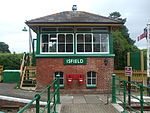Barcombe Mills is a small settlement and an area of countryside including a local nature reserve near the village of Barcombe Cross in East Sussex, England. It is located in the civil parish of Barcombe in the Lewes District. It is an important area for its wildlife, natural environment and water storage. The River Ouse and Andrew's Stream, one of its tributaries and popular for fishing, flow through the area and Barcombe Reservoir is adjacent. The area includes a small hamlet and some farms, including Barcombe House, and a water treatment works.
There were mills in the parish of Barcombe as far back as the 11th century. Thomas and Denise Erith are recorded as holding a corn mill at the beginning of the 16th century. Although the original mills were destroyed by fire in 1939, several pillboxes from the Second World War, a beautiful large brick bridge and many weirs remain.
The old road through the Mills features a former toll bridge which still displays its tolls in pre-decimalisation currency and a plaque mentioning that it was featured in the Domesday Book commissioned by William I.
The local pub is the Anchor Inn, where canoes can be hired for trips down the Ouse. This public house, however, is situated about a kilometre to the north of the main hamlet and cannot be accessed directly by road from Barcombe Mills. It can be accessed along the disused trackbed of the railway or by walking over footpaths. It can also be reached by car by driving into the village of Barcombe Cross and turning right; it is then signposted down the dead-end Anchor Lane. The pub's address is in Barcombe Mills but it is generally considered as an offshoot of Barcombe Cross or Spithurst.
The disused Barcombe Mills railway station served the village until 1969.
Now just a collection of houses and a water treatment works, the area once had a thriving community. A pub called the Anglers' Rest (formerly known as the Railway Inn) closed in the 1990s. This was situated next to the former railway station. A restaurant was also present in the former railway station and this closed soon after the pub. Many more houses were also present at one time when the oil mills and the button factory still existed on the banks of the Ouse. The tributaries, weirs and millstreams cut to feed this are still obvious today - this is why the river takes such a bizarre course at Barcombe Mills. The hamlet is signposted from the village of Barcombe Cross but from nowhere else. In early 2018 two village signs were erected along Barcombe Mills Road, one at either side of the hamlet.
Since it has lost many of its services it has reduced to a quiet backwater consisting of houses, farms and the Bob Davis Scout Hut which is used by the 1st Barcombe Scout Group in the summer months.











